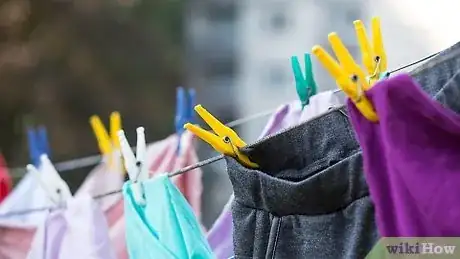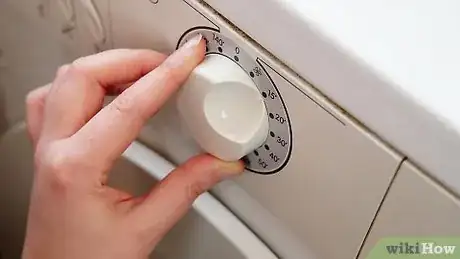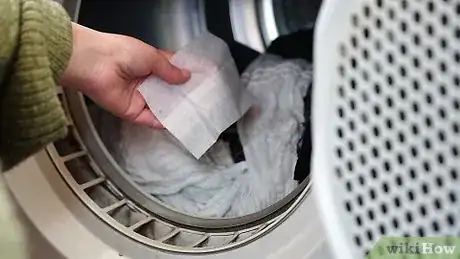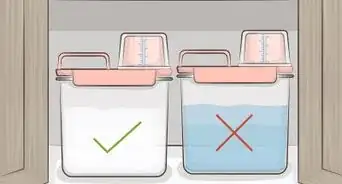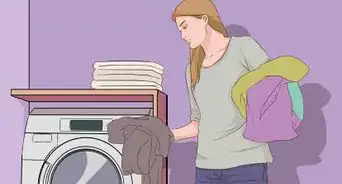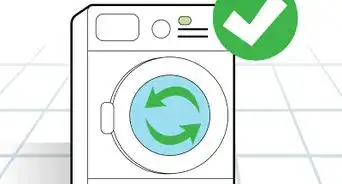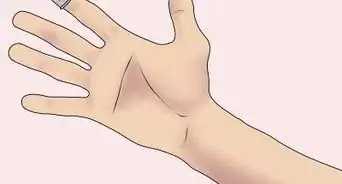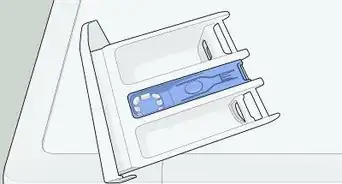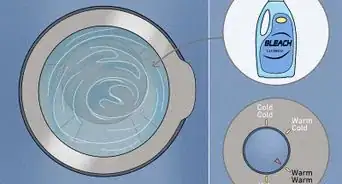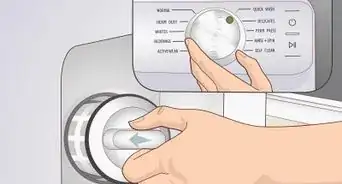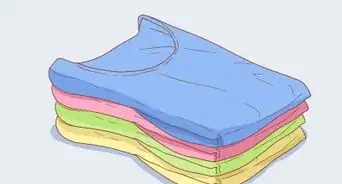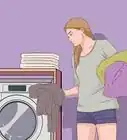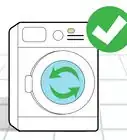This article was co-authored by Kamel Almani. Kamel Almani is a Laundry and Cleaning Specialist and the Co-Owner of WashyWash, a toxin-free and eco-friendly laundry and dry clean service based in Amman, Jordan. Kamel and his staff at WashyWash use Blue Angel certified and dermatologically-tested detergents. They also combine EcoClean and digital technology to provide an eco-friendly, convenient, and quality cleaning service. Kamel holds a BA in Design from the University of Applied Science, Amman.
There are 12 references cited in this article, which can be found at the bottom of the page.
wikiHow marks an article as reader-approved once it receives enough positive feedback. In this case, 100% of readers who voted found the article helpful, earning it our reader-approved status.
This article has been viewed 141,447 times.
Static cling on laundry can be a big inconvenience. Dealing with static cling on clothes can be an irritating part of doing laundry. Preventing static cling, however, can be achieved both before and after you do the laundry with sprays, implements, and a basic understanding of how static cling occurs.
Steps
Using Sprays and Liquids to Prevent Static
-
1Add vinegar to the laundry after the rinse cycle. Simply pour 1/4 to 1/2 cup of white vinegar to the laundry load during the rinse cycle and your clothes should come out clean and static free. This is an especially good choice for cotton clothing or sheets, but it doesn’t do as well with fleece or polyester.[1]
- The vinegar will also keep soap residue off the clothes as they’re rinsed.
-
2Use post-laundry sprays which reduce static cling. A popular product known as Static Guard is one such product which can eliminate static charge in clothes after they dry. Sprays contain special compounds which discharge static electricity in clothes. They can be applied to freshly cleaned clothes to make them static-free. Simply point the nozzle at the article of clothing in question and squeeze the top. A mist of aerosolized liquid will eject from the can.
- Try making a DIY spray by mixing 1 bottle cap of fabric softener into a spray bottle filled with water.[2]
Advertisement -
3Use fabric softener. Fabric softeners are liquid concoctions of chemicals used to make fabric softer. They impart a pleasant odor to your clothes and are capable of preventing static cling in laundry as well.[3] Popular brands include Downy, Bounce, and Snuggle. Each softener has directions on the back of the container. Generally, you must pour them into your washing machine during the rinse cycle, then allow the cycle to run as normal.[4]
- If your washing machine has a built-in fabric softener dispenser, pour the fabric softener into it. If not, add the liquid to the washing machine itself after adding the clothes.
- You can also purchase laundry detergent with fabric softener added to it.
-
4Spray distilled water on your clothes after they come out of the dryer. Spraying a fine mist of distilled water across the surface of the clothes as they come out of the dryer will prevent them from being too dry and sticking to each other or other surfaces, which can lead to the buildup of static charge. Fill a standard size spray bottle with distilled water and give the handle one good pump across the surface of your clothes from a distance of approximately two feet.
Preventing Static By Adjusting the Washing and Drying Conditions
-
1Line-dry your clothes. Air-drying can prevent static cling altogether.[5] If you have to use a dryer, take your clothes out of it as soon as they are sufficiently dry or while they are still slightly damp. Over-drying your clothes can lead to static cling.
- Static happens when there's friction between two electrically insulating materials, especially in a dry environment—like a clothes dryer.[6]
-
2Separate clothes by material. Some materials are morel likely to build up static electricity than others.[7] Synthetic materials like polyester, nylon, rayon, and acetate tend to develop high levels of static cling after washing. Natural fabrics like cotton, wool, linen, and silk, on the other hand, tend to stay relatively static-free. Washing and drying natural and synthetic fibers in the same cycles can result in static cling on all your clothes, so it’s a good idea to wash them separately.
- Alternately, you could choose to dry the natural materials in the machine and dry the synthetic materials on the line.[8]
-
3Use a humidifier.[9] A damp environment prevents clothes from sticking to each other as much as they do when they are very dry. While letting your clothes dry on the rack or on the line, run a humidifier. A humid atmosphere makes the air more conductive than the clothes for the buildup of static charges, which essentially makes the clothes a less attractive target. Running a humidifier during especially dry seasons like winter will also prevent buildup of static electricity on your clothes and body.
- A drying rack is a small rack of wood or plastic with several parallel rungs upon which clothing can be set to dry.
-
4Limit the amount of time your clothes spend in the dryer. Instead of letting them run the full hour-long cycle, let them run only 45 minutes. Remove them and hang them on hangers or a washing line to dry the rest of the way. You’ll save money by running the machine for a shorter period and reduce your carbon footprint in addition to limiting the static cling of your clothes.
Preventing Static With Dryer Additives
-
1Place a dryer sheet in your dryer. Dryer sheets contain positively-charged ingredients which are released only when in the presence of static electricity. Their presence ensures electrical charges will be neutralized. To use dryer sheets, simply place one (or two for large loads) on top of wet clothes in the dryer before running it.
- Dryer sheets do more than just remove static. They also lend a pleasant, fresh fragrance your laundry.
- You can also rub laundry sheets on your clothes to "wipe away" static after they come out of the dryer.[10]
-
2Attach some safety pins to your clothes before putting them in the dryer. Adding two safety pins to a sock will channel the static electricity into the pins. Think of them as a lightning rod for static charges in the dryer. Attach the safety pins to the sock when the clothes are wet and being transferred from the washer to the dryer.
- You can also rub a metal hanger across the surface of each item of clothing after removing it from the dryer to discharge static.
-
3Consider using dryer balls. These are small balls of foil, plastic, or wool which, when placed in a dryer with your clothes, reduce static cling. Since static develops from the friction of clothes rubbing against each other, adding an object like a dryer ball to the mix can add a layer between clothes which prevents them from accumulating the electrical charge which causes static. Other benefits of dryer balls include keeping your clothes separated and fluffy.
- You could, instead of using a commercial or homemade dryer ball, use a tennis ball or even some clean, soft sneakers.[11]
-
4Use an aluminum foil ball. While similar to the dryer ball, the aluminum foil ball actually works on a different principle, and causes the static to accumulate in the aluminum foil ball, not in the clothes. Using regular aluminum foil of the variety commonly found in kitchens, cut about three or four square feet of aluminum. Crunch it loosely into a rough ball, then smooth it in your hands by rolling it between your palms until it becomes rounded. Each should be two to three inches across when finished. Toss three or four balls in the dryer along with your clothes.[12]
-
5Wash your laundry with soap nuts. Soap nuts are a type of berry which possesses anti-static properties. To use soap nuts, drop a handful (5-6) in a muslin bag. Tie it off and drop it into the regular laundry load before starting the washing machine.
- When using soap nuts, you can eliminate or reduce the volume of detergent. Be sure to use them with hot water for best results.[13]
Community Q&A
-
QuestionWill using special dryer sheets on already-dry clothing reduce the static and will this harm the clothing?
 Community AnswerThere doesn't need to be anything "special" about them. As indicated in the article, the anti-static sheets work on clothes even after they come out of the dryer. Also, as stated, over-drying makes static worse. If you simply dry your clothes less, your problem may go away. Dryer sheets can damage man-made fabrics like spandex.
Community AnswerThere doesn't need to be anything "special" about them. As indicated in the article, the anti-static sheets work on clothes even after they come out of the dryer. Also, as stated, over-drying makes static worse. If you simply dry your clothes less, your problem may go away. Dryer sheets can damage man-made fabrics like spandex.
References
- ↑ http://naturesnurtureblog.com/natural-ways-to-get-rid-of-static-cling/
- ↑ http://stylecaster.com/how-to-get-rid-of-static-cling/
- ↑ Kamel Almani. Laundry & Cleaning Specialist. Expert Interview. 13 April 2021.
- ↑ http://www.mamaslaundrytalk.com/how-to-remove-static-cling-from-clothes/
- ↑ Kamel Almani. Laundry & Cleaning Specialist. Expert Interview. 13 April 2021.
- ↑ http://www.mamaslaundrytalk.com/how-to-remove-static-cling-from-clothes/
- ↑ https://www.holmesproducts.com/how-to-get-rid-of-static-electricity-in-your-bedding.html
- ↑ http://www.homeremedyhacks.com/16-home-remedies-to-get-rid-of-static-cling-in-clothes/
- ↑ http://www.getridofthings.com/household/get-rid-of-static-cling/
- ↑ http://www.mamaslaundrytalk.com/how-to-remove-static-cling-from-clothes/
- ↑ http://www.popularmechanics.com/technology/gadgets/reviews/a4795/4334763/
- ↑ http://www.cnet.com/how-to/use-a-ball-of-aluminum-foil-to-eliminate-static-in-the-dryer/
- ↑ http://www.greenideareviews.com/2013/07/28/washing-laundry-with-soap-nuts-review-do-they-work/



